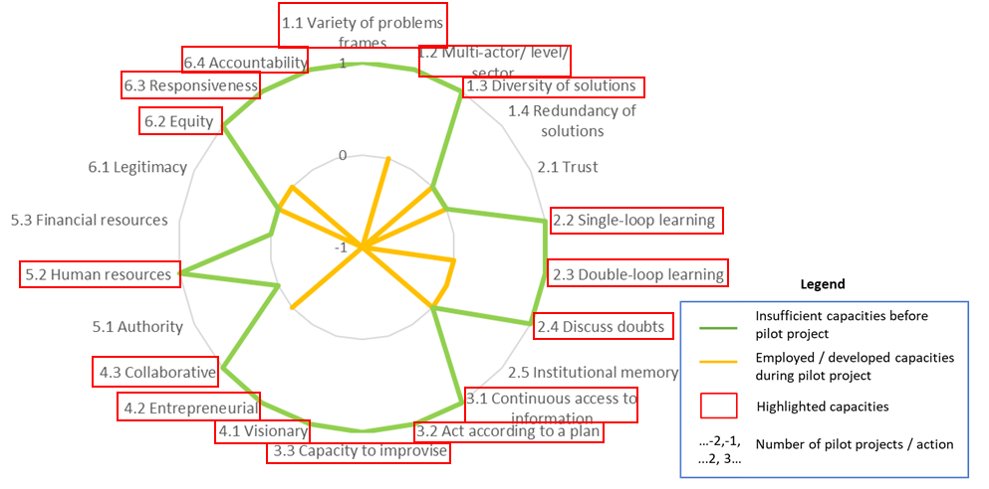Recovery learning
What is recovery learning?
Recovery learning or resilient recovery is a way to improve flood recovery by learning from past events. It builds resilience during recovery and promotes resilience in regular development. Resilient recovery is a means to sustainable development (DRFG, 2020).
Recovery learning and FRAMES
Flood events can be devastating causing large impacts associated with high economic costs and slow recovery afterwards. For instance, the flood event of 2013 that happened in Jyllinge Nordmark, Roskilde, caused an economic damage of 2.5 mil euros and 7 years later people are still not completely recovered. It is important to learn from previous flood events to improve flood recovery. Therefore, in FRAMES, the Roskilde pilot project focused on learning from this recovery process to improve recovery capacity in case of future flooding in Denmark.
How is recovery learning linked to the layers?
The resilient recovery pilot in Roskilde benefits the other layers of the MLS approach in the following way:
- Layer 3, preparedness and response: (a) raised flood risk awareness leads to capacity building among farmers/landowners for flood preparedness; (b) improved flood preparedness and emergency planning of communities when following the guidelines; c) increased overall community resilience when guidelines are implemented at local level.
- Layer 4, resilient recovery: improved recovery capacity of communities by developing guidelines with relevant information about what to do in case of a flood event (before, during, after) to reduce the vulnerability of people and areas by reducing social and economic impacts.
Lessons learnt
For a full list of the main lessons learnt from the pilots working on resilient recovery, please click here.
Relevant adaptive capacities
To accomplish actions successfully, certain capacities are more needed than others. More specifically: the combination of flood risk management strategies in response to climate change depends on the adaptation space and capacity of institutions (Berkhout, Hertin and Gann, 2006). Since institutions have the ability to stimulate the capacity of a society to adapt to climate change from the local to the national level (Gupta et al., 2010), stakeholders and organizations involved in FRAMES focused on the development of adaptive capacities at local and regional level.
The adaptive capacities that were employed and developed during the pilot project working on resilient recovery are shown in the spiderweb below. We will provide more detail for those capacities that significantly increased during the pilots.
 Figure : Development of adaptive capacities in recovery learning
Figure : Development of adaptive capacities in recovery learning
- Single loop learning: learn from the past. This pilot analysed what happened, recovery wise, after the last flood event. The findings were used to improve flood risk management by taking non-structural measures in the form of guidelines to improve recovery and drafting up flood emergency plans.
- Multi-actor, multi-level, multi-sector: floods are not a one-dimensional event. Involve all relevant stakeholders when looking at FRM. In this case the insurance companies, municipalities, coastal management authority, citizens, knowledge institutes and crisis management authorities were involved to assess the recovery process in Roskilde. With the input from all, a step-by-step guide was developed to better understand the entire process of flood risk management and inform citizens about what to do and who to contact in each phase of a flooding event.
- Diversity of solutions: combine the layers. The guidelines prepared for this pilot looked at not only the recovery process but also at flood preparedness
- Double loop learning: integrate new knowledge into policy. The findings from this pilot for instance, were included in the Danish Floods Directive Risk Assessment Plans.
- Continuous access to information: share what you know with all involved. Regular meeting were information was shared with the stakeholders were an essential part of this pilot and the guidelines are available for everyone who is interested.
- Act according to a plan: provide clear information for every level. The guidelines resulting from this pilot for instance, include clear steps on what to do and who to contact in case of a flood event. In addition, information on how to improve the communication between local communities and local authorities regarding flood preparedness and recovery is also included. In addition, the guidelines also clarify what authorities have responsibilities in a flood recovery process.
- The knowledge and the expertise (human resources) developed in this pilot project enhanced the capacity of communities (capacity to improvise) to take actions (entrepreneurial leadership) as well as collaboration between communities and local authorities (collaborative leadership).
What tools were used in the recovery learning pilot?
There are many tools that can be used to increase resilient recovery. The FRAMES pilots have selected and successfully used the tools listed in the table below. More information can be found by clicking on the links provided.
We also uploaded a full list of all tools used to improve the management of MLS.
| Name of tool | Main objective | Description |
| Stakeholder analysis | Identify all stakeholders in the area | A stakeholder analysis will identify all actors along with their interests and potential issues who will have a role in MLS before engaging them in the process. |
| Surveys | Collect data regarding perceptions and awareness of stakeholders | Surveys collect data about the perceptions and level of awareness of inhabitants, stakeholders, policy makers and organisations about (perceived) flood risk, flood preparedness and flood recovery. |
| Interviews with stakeholders | Collect data from stakeholders in the area | Interviewing stakeholders can result in more specific insights on their knowledge, perceptions, views and opinions on specific flood risk measures. |
| Social media | Communication and dissemination | To increase and improve the flood awareness and self-efficacy of citizens and organizations, social media channels are advised to be used: YouTube, Twitter, Facebook, local press (TV, newspaper, magazines, radio), websites, newsletters, brochures, leaflets, events and meetings. · |
